clothing
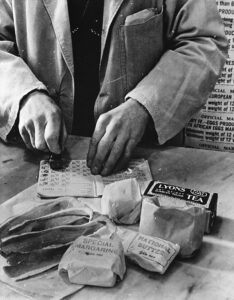
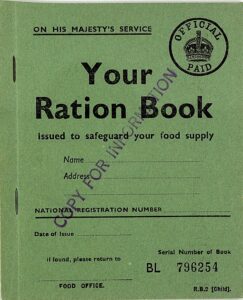 When my dad, Staff Sergeant Allen Spencer, was serving in the Army Air Force during World War II, rationing was not an unusual thing. Nevertheless, most of us think of rationing to be in the form of gas rationing. That is pretty much the kind of rationing we have heard being used these days, but on January 8, 1941, the government of the United Kingdom began a different kind of rationing…food. I can see the value of such a thing, because by limiting the amount of food each person could have, they could ensure that everyone was able to get enough food to sustain them. People weren’t going to gain weight on the amount of food allowed, but they could survive. I suppose the fact that there were so many extra people, in the form of the military forces, just added to the need to ration.
When my dad, Staff Sergeant Allen Spencer, was serving in the Army Air Force during World War II, rationing was not an unusual thing. Nevertheless, most of us think of rationing to be in the form of gas rationing. That is pretty much the kind of rationing we have heard being used these days, but on January 8, 1941, the government of the United Kingdom began a different kind of rationing…food. I can see the value of such a thing, because by limiting the amount of food each person could have, they could ensure that everyone was able to get enough food to sustain them. People weren’t going to gain weight on the amount of food allowed, but they could survive. I suppose the fact that there were so many extra people, in the form of the military forces, just added to the need to ration.
Of course, some food rationing occurred before this date too. Rationing was introduced temporarily by the government of the United Kingdom several times during the 20th century, during and immediately after a war. At the start of World War II in 1939, the United Kingdom was importing 20 million long tons of food per year, including about 70% of its cheese and sugar, almost 80% of its fruit and about 70% of its cereals and fats. It also imported more than half of its meat and relied on imported feed to support its domestic meat production. The civilian population of the country alone, was about 50 million. It was one of the principal strategies of the Germans in the Battle of the Atlantic to attack shipping bound for Britain, restricting British industry and  potentially starving nations into submission. Siege tactics were not unusual and have been used throughout history by several countries.
potentially starving nations into submission. Siege tactics were not unusual and have been used throughout history by several countries.
So, to deal with the various forms of shortages, and sometimes extreme shortages, the Ministry of Food instituted a system of rationing. Basically, the Ministry of Food would buy most rationed items, forcing anyone who wanted some of these items to register at chosen shops. Upon registration, they were provided with a ration book containing coupons. The shopkeeper was provided with enough food for registered customers. Purchasers had to present ration books when shopping so that the coupon or coupons could be cancelled as these pertained to rationed items. Rationed items had to be purchased and paid for as usual, although their price was strictly controlled by the government and many essential foodstuffs were subsidized. Basically, rationing restricted what items and what amount could be purchased, as well as what they would cost. To make matters worse the items that were not rationed could be scarce, because the Ministry of Food did not purchase said items. The priced for some of the unrationed items were also controlled by the Ministry of Food, and for many people those prices were too high for them to be able to afford, causing people to try to cheat the system, and merchants to try to either assist the people or to gouge the public in order to make a buck. This brought penalties for 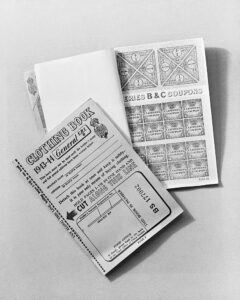
 breaking the laws of rationing.
breaking the laws of rationing.
During the World War II, rationing was not restricted to food, and was part of a strategy including controlled prices, subsidies, and government-enforced standards. The goal for this controlled pricing and rationing was to manage scarcity and prioritize the armed forces and essential services with the supplies they needed first. They did still try to make available to everyone, an adequate and affordable supply of goods of acceptable quality. I suppose that how well they accomplished their goal, would be a matter of opinion. Of course, like all wars, World War II ended, as did the rationing of the time, but rationing has returned a number of times, and will again, should the need arise.
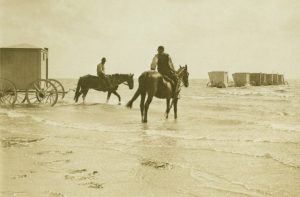 In the 18th and 19th century, going swimming was not done in the same way as it was today. While it was considered ok to swim, the clothing was not considered appropriate, and so men and women were segregated during swimming. I don’t suppose going to the beach was as common, and so it problem might not have come up every day, but it came up enough to create a need for a “proper” way to accomplish an outing involving swimming. Enter the Bathing Machine. The bathing machine was basically a small room built on wheels that could be taken to the beach. People entered the machine while it was on the beach, wearing their street clothing. In the machine they changed into their bathing suit, although men were allowed to bathe nude until the 1860s. They then placed their street clothes into a raised compartment in the bathing machine, where they would remain safe and dry.
In the 18th and 19th century, going swimming was not done in the same way as it was today. While it was considered ok to swim, the clothing was not considered appropriate, and so men and women were segregated during swimming. I don’t suppose going to the beach was as common, and so it problem might not have come up every day, but it came up enough to create a need for a “proper” way to accomplish an outing involving swimming. Enter the Bathing Machine. The bathing machine was basically a small room built on wheels that could be taken to the beach. People entered the machine while it was on the beach, wearing their street clothing. In the machine they changed into their bathing suit, although men were allowed to bathe nude until the 1860s. They then placed their street clothes into a raised compartment in the bathing machine, where they would remain safe and dry.
I believe that all bathing machines had small windows, but one writer in the Manchester Guardian of May 26, 1906 considered them “ill-lighted” and wondered why bathing machines were not improved with a skylight. Once the person had changed, the machine would be wheeled or slid into the water. The most common type of these machines had large wide wheels and were pulled in and out of the surf by a horse or a pair of horses with a driver, but there were some that were pushed in and out of the water by human power. Some resorts had wooden rails into the water for the wheels to roll on, and a few had bathing machines pulled in and out by cables propelled by a steam engine.
Once the machine was in the water, the occupants stepped out from the sea side, and proceeded down steps into the water. Many of the machines had doors front and back, but those with only one door would be backed into the sea or need to be turned around. The most essential element of the machines, was that it blocked any view of the bather from the shore. Some of the more luxurious machines were equipped with a canvas tent lowered from the seaside door, sometimes capable of being lowered to the water, giving the bather greater privacy. Bathing machines would often be equipped with a small flag which could be raised by the bather as a signal to the driver that they were ready to return to shore. Some resorts even employed a dipper, a strong 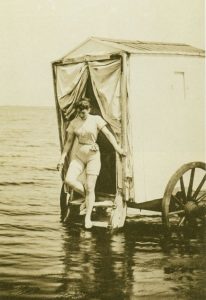 person of the same sex who would assist the bather in and out of the sea. Some dippers were said to push bathers into the water, then yank them out, considered part of the experience. Wow!! I’m not sure I would like that much, but then, to me this whole process seems like it would make the idea of bathing a bit too much of an undertaking, not to mention the added cost to go swimming, because I don’t think anyone would operate a bathing machine for free.
person of the same sex who would assist the bather in and out of the sea. Some dippers were said to push bathers into the water, then yank them out, considered part of the experience. Wow!! I’m not sure I would like that much, but then, to me this whole process seems like it would make the idea of bathing a bit too much of an undertaking, not to mention the added cost to go swimming, because I don’t think anyone would operate a bathing machine for free.
Bathing machines were most commonly used in the United Kingdom and parts of the British Empire with a British population, but were also used in France, Germany, the United States, Mexico, and other nations. Legal segregation of bathing areas in Britain ended in 1901, and the bathing machine declined rapidly. By the start of the 1920s, bathing machines were almost extinct, even on beaches catering to an older clientele. For those of us who grew up in the modern era, this process would seem like a bit of insanity, but then that was simply a different time.
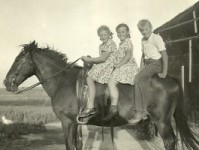 Back in the day, girls pretty much wore dresses all the time. In fact, girls wearing pants were considered…risque, loose, or maybe backward. By the mid 1900’s things had changed to a degree, and pants were ok for certain activities. Nevertheless, many girls just didn’t own pants, so they continued to wear dresses for activities we would consider it to be inappropriate to wear dresses for today.
Back in the day, girls pretty much wore dresses all the time. In fact, girls wearing pants were considered…risque, loose, or maybe backward. By the mid 1900’s things had changed to a degree, and pants were ok for certain activities. Nevertheless, many girls just didn’t own pants, so they continued to wear dresses for activities we would consider it to be inappropriate to wear dresses for today.
One of those activities was horseback riding. Early on when the women started riding horses, it was considered taboo for them to straddle a horse. People really thought of them as having very low moral standards. That was when the side saddle came about. The big problem with that was that the horse had to be very well trained, because the woman had a lot less control over the horse when it was side saddle. To me, side saddle seems like it would be an extremely awkward way to ride. I think it would feel like you were hanging on a wall…much like a painting.
Then, when people moved out west, they began to leave those civilized ideas of the east 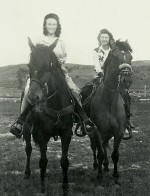 behind them. It was a necessity, because many of the horses were wild and then tamed, and people lived on homesteads the were a long way from their homes. And then, of course, was the fact that sometimes you had to outrun the dangers of the region, like Indians, wild animals, and outlaws. Running from danger was no time to be a lady in a side saddle…if you wanted to live, that is. Watching the old westerns, I remember thinking how funny it looked to have those long dresses draped over the back end of a horse.
behind them. It was a necessity, because many of the horses were wild and then tamed, and people lived on homesteads the were a long way from their homes. And then, of course, was the fact that sometimes you had to outrun the dangers of the region, like Indians, wild animals, and outlaws. Running from danger was no time to be a lady in a side saddle…if you wanted to live, that is. Watching the old westerns, I remember thinking how funny it looked to have those long dresses draped over the back end of a horse.
Now, of course, many women rarely wear a dress at all, much less to ride a horse. Women have found that it is far more comfortable to live most of their lives in jeans, so dresses are reserved for special occasions. Nevertheless, there was a time, a very different time, when women wouldn’t have ever considered things like wearing men’s pants or straddling a horse.

 Today is my birthday. The last few days, I have been reflecting on my birthday, and my dad’s birthday just two days before mine, and how much I miss him, and what my parents mean to me. Your parents give you so much, as a baby. They supply everything you need, like food clothing, warmth, love…eveything. But before that, there was something more they did. It was something even greater…the greatest gift. They gave you life. How do you thank them for that? Oh, I know, my parents had me and my sisters, because they wanted a family, but it was their desire for a family that gave me life. It was likely something they gave little thought to…that this was a gift to me, but that is exactly what if feels like to me. The greatest gift.
Today is my birthday. The last few days, I have been reflecting on my birthday, and my dad’s birthday just two days before mine, and how much I miss him, and what my parents mean to me. Your parents give you so much, as a baby. They supply everything you need, like food clothing, warmth, love…eveything. But before that, there was something more they did. It was something even greater…the greatest gift. They gave you life. How do you thank them for that? Oh, I know, my parents had me and my sisters, because they wanted a family, but it was their desire for a family that gave me life. It was likely something they gave little thought to…that this was a gift to me, but that is exactly what if feels like to me. The greatest gift.
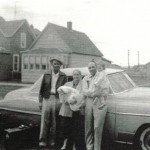
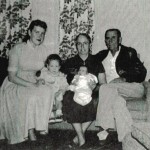
When I arrived I was nurtured by my mom and dad. When I came home, I met my sister Cheryl, who loved me very much. Like me, she had been given the greatest gift our parents could give us…the gift of life. Because we lived so far away from my mom’s family then, my grandparents made the trip from Casper, Wyoming to Superior, Wisconsin to visit us, and share in the joy of our growing little family. Cheryl and I felt so blessed to have the happiest life there could possibly be. She and I played in our little world, mostly just the two of us, but also with our cousin, Pam, for the next three years in Superior, Wisconsin.
Our family moved back to Casper, where my sister, Caryl was added to our family, 3 years 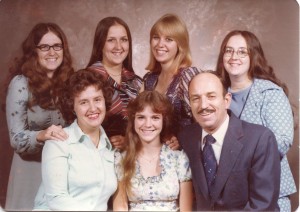 after I was born. Then two years later, Alena, and two years after that, Allyn. Each of us had been given the same greatest gift from our parents. And along with that greatest gift, they had also given us another second greatest gift…the gift of siblings. My parents and my sisters have always been so dear to me. Our family has always been very close, and as it continues to grow, more and more blessings are added. With each new family member, by birth or by marriage, the greatest gift, keeps on giving. So today, on the anniversary of my birth, I want to thank my parents for giving me life. Your gift was so precious and loving…the greatest gift…ever.
after I was born. Then two years later, Alena, and two years after that, Allyn. Each of us had been given the same greatest gift from our parents. And along with that greatest gift, they had also given us another second greatest gift…the gift of siblings. My parents and my sisters have always been so dear to me. Our family has always been very close, and as it continues to grow, more and more blessings are added. With each new family member, by birth or by marriage, the greatest gift, keeps on giving. So today, on the anniversary of my birth, I want to thank my parents for giving me life. Your gift was so precious and loving…the greatest gift…ever.

